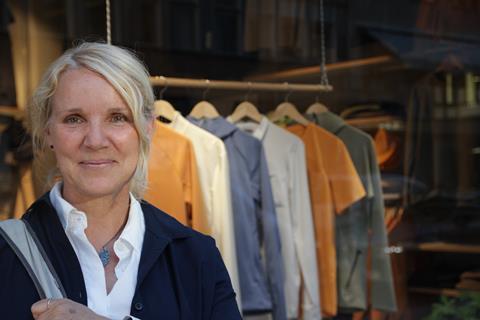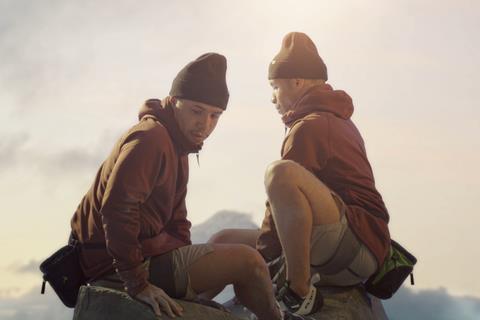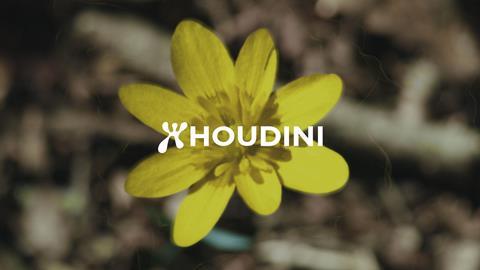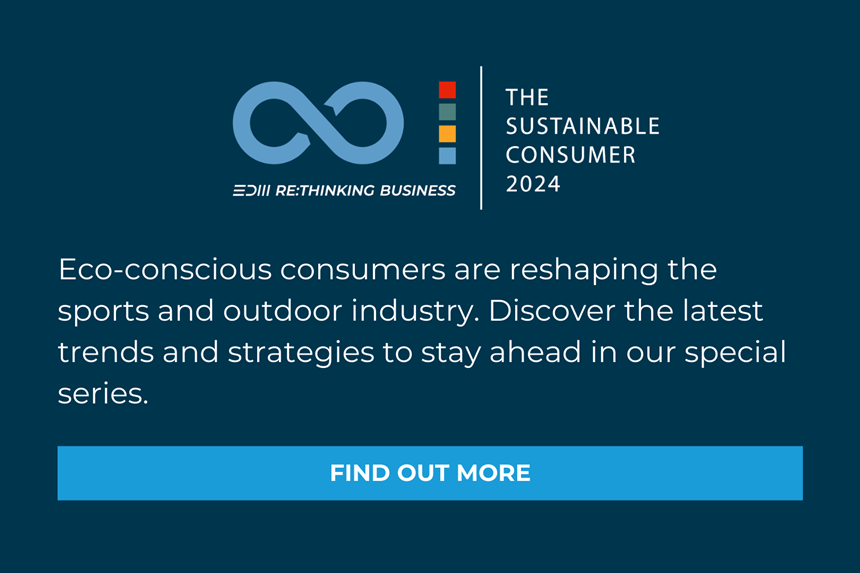Houdini CEO Eva Karlsson has grown a clothing business that is more than 80% circular, making some bold business choices along the way. In this interview she talks about establishing an industry definition of “circularity,” the importance of building a bond with products, and what “value” and “growth” should really mean for today’s brands.

SGI: Can we congratulate you for being 100 percent circular in 2022? That was your goal with Houdini.
Eva Karlsson: I’m afraid not, but we’re very close. We are more than 80 percent circular in design, sourcing, production and assembly; so that not only what goes in is circular, but also the end result is a pure, usually mono-material design which can be recirculated time and time again.
We have a couple of products that are still linear by design, but clearly promote a circular user-phase — including high frequency and versatility of use, care and repair, and reuse. They are loved companions, used for many different activities, and they last for more than a decade. They’re also circulating in our rental system. So, there is plenty of circularity in there, even though we haven’t yet solved the material issues. This is a typical Houdini dilemma, or healthy friction, and why we always look at the holistic impacts — positive and negative — and assess them scientifically.
We take extended producer’s responsibility. Products are returned to us either for recycling, reuse, or second-hand sales (or reuse as we call it). Since 2006, all worn-outs that have been returned to us which cannot yet be recycled are stored at our warehouse. As owners of natural resources in the shape of fibers, fabrics, or products, we have committed to being a custodian of those resources. The way we see it, ownership gives us the right to use but not the right to waste. With ownership comes the responsibility to care for, and bring back, those resources into the system; for us and future generations to use.
The meaning of circularity
It seems like for circularity, everybody is talking about slightly different things. What does circularity mean for Houdini?
Exactly. There’s no clear definition of circular, which is a challenge for the much-needed collaboration in the industry as well as for honest and educational communication with customers. For this, we need to talk about the same things, using the same words. The way Houdini defines circularity is, mimicking the continuous flows and circularity in nature. It’s about a circular flow of raw materials, which is why we design for circularity, take back, reboot, or store and recycle. That’s one circular flow: the natural resources flow.
Then we are also exploring the flow of products. How can you, as a user, potentially share your clothing layers with friends? Could you choose to buy second-hand? Could you rent rather than buy? We have added peer-to-peer reuse flows and with this you can sell an old Houdini garment to somebody else in our ecosystem. So, we’re trying to make sure that the flow of products and the sharing of products is strengthened. It’s in how we design our digital ecosystem and how we enable our stores and our retailers; we even have rental retailers today, which is so cool.
The third element is also really important: That’s the circular flow of knowledge, insights, and sharing of technology. Having an open-source mindset. This is part of our circular philosophy, and it’s something that works perfectly in nature. Nature is an open-source system, and that’s how it evolves. Open source for us means collaborating and sharing technologies and insights, creating feedback loops, and finding ways of inspiring and sharing knowledge with customers and users. Like, how to care for products and how the impact is reduced if you use your products a lot rather than a little. Natural resources, the product, and knowledge — these three flows are what we look at when considering circularity.
Coming back to the first of your three circular pillars, when it comes to the product, the supplier is crucial. Can you tell us a bit more about your supplier-brand journeys?
We have few rather than many partners. They happen to be spread out globally because we’ve chosen the best, true specialists in their respective fields, who are eager to move with us on the transition towards circularity. In 2006, we found a supplier partner in Japan — Teijin — that had a fully circular solution in place. We work closely with Polartec. Reda is an important partner for merino wool fabrics (find the full list of suppliers and producers here).
On the consumer side, you offer every option for enhancing circular use: Resale, renting, repairing. Could you compare how successful they are?
I think the coolest thing is seamless circular use independent of business models. You can use a product in a circular way just by keeping it for a long time: Caring for it, sharing it with others, and then at the end of the day, bringing it back to us for recycling. I think it’s a combination of educational storytelling but even more importantly, the design of the product itself that creates a bond between the product and the user. We want to design products that you not only fall in love with but stay in love with. Back in the day, that was a given because people invested in fewer things and kept them for their whole lives. It was a big mistake for us to move in another direction as a society. But the longing for relations rather than transactions is human and it’s just a matter of tapping into that human aspect; designing products accordingly without compromise. These products might appear expensive at the time of purchase, but if you look at cost per use they often become the smartest, most cost-effective buy.
But you have to take into consideration margins and price points.
We’d rather create and put products on the market that actually make sense. Sometimes that takes a bit longer, quite a lot longer, but that’s how great products are made. As an added benefit, you then also have the foundation for reuse as an additional business model. This is the circular business model that’s currently growing the fastest. I think it’s an easy one for most brands to implement because it requires only a small amount of extra infrastructure that you don’t have for normal sales.
A rental or subscription model needs more infrastructure, a new business system, and software, so these models are slower in development. Both are viable in our seamless ecosystem. At the moment we are only doing rentals in the Nordic countries, because if you take freight into consideration, it isn’t really a sustainable alternative to ship back and forth across continents. It needs to be regional. So we’re building within regional clusters one step at a time. Rental and subscription business models will become more attractive, due to price increases, and hopefully also due to a healthier outlook on how you use and shop for products. I have high hopes for quality products from any brand gaining strength in this newer world we’re entering into, compared to fast fashion, or fast outdoor or sports goods.
Profitable business: living wage is a must
The things you do are complex and expensive. I wonder how this results in a profitable business?
The fact is that profits are often made by compromising people in the value chain, and the considerations of ecosystems are equally poor. Houdini has chosen to build a way of working with limited overheads compared to other brands in order not to compromise others, be it people or ecosystems. When we look at our team and extended team, including our value chain, a living wage for instance is a must. We are proof that you can build a resilient and strong long-term business, even now, without making such compromises. We have made choices in how we operate, with slightly less room for marketing expenses, but that is a small price to pay knowing that you are creating value for all. This is also what our customers expect from us as a brand. I hope for — and I believe in — exponential change in customer expectations in this direction. I think the general public’s expectations of what corporations need to deliver to society are about to change radically. So we’re investing in the future; ours, our kids’, and the planet’s. A win-win.

And this way of operating is already successful today…
We don’t operate in the red. We are profitable but it’s a balancing act. We are cultivating value not only for our customers and ourselves but for everyone in our value chain. And we are on a journey not only towards circularity but towards regeneration, which means the value cultivation that we provide in terms of ecosystem restoration or for society does more than reduce the negative impacts we have. Ultimately, we have to eliminate the negative impact and scale up the positives.
How can bigger companies, that are looking for shareholder value more than stakeholder value, transform and change their philosophy of economic growth?
I think companies really have to transform or die. Including us. Value creation is about so much more than money. Value is happiness, health, and prosperity for humans and the species we share this planet with. I’m pretty sure we would all choose life rather than the death-spiral of growth we’re in. The problem is, we are disconnected from the living world and from nature, which we are part of. When we’ve managed to reconnect to ourselves and to nature, the choices we make will be different.
De-growth implies an “economic” world
Let’s lean into that optimistic vision. What does our sporting goods/fashion/outdoor world look like in ten years?
I hope that the outdoor industry will have evolved forward into a new version of what it used to be in terms of creating tools for an active life. We need less anxious brands, and more brands with integrity and a sense for what they are truly good at. We will not only look at monetary growth as the marker of success but also growth in the sense of having employees and a company culture that grows; becoming more knowledgeable, caring, and compassionate.
Is “de-growth” the right expression?
That’s an expression that’s been around for a while. But de-growth is a word that implies we accept that the economy is our world; that I am nothing more than a consumer. Growth is so much more than money. I don’t want to de-grow. I want to grow, even if it’s not in a monetary sense. It’s not about becoming bigger, expanding into new markets, and out-competing a competitor. It’s more collaborative, humble, and about sharing and gaining, together.

What must a business do to transform?
It’s a process. It’s about acknowledging that you are linear and that linearity is a degenerative, destructive way of working. And then moving further into knowledge and innovation, identifying solutions that are actually mitigating negative impacts. Choosing an alternative technology that sounds better is not enough. We need to know it is better. I think that is why we started collaborating. We weren’t big. We weren’t able to solve linearity on our own. Either it wasn’t possible because we needed an overhaul of internal processes, or it wasn’t possible because we couldn’t decide if this or that solution was better. So we had to work with the Stockholm Resilience Center and Planetary Boundaries to understand the impact on the planet. The knowledge base has to be increased via curiosity and collaboration to make change happen and to realize there is no quick fix. The nice thing is, that if we go circular in terms of product, there’s still the circularity in terms of use and lifestyle, and then there’s regenerative solutions as the next step. It’s a balancing act of being very patient and impatient.
What about the marketing for a slow-evolving brand like Houdini? Marketing and communication are in general about the new and the habit of the consumer to buy. How do you steer the marketing wheel in a completely different direction?
Again, it’s about reflecting on what value — and what added value — we provide. We can guide users in layering for activities, how to better care for their garments, and we can assist with repair guides. We recently launched a campaign celebrating the old, scared, repaired, yet still-going-strong Power Houdis out there, with the ambition of making people feel proud about wearing the same products for years and the beauty in that. It focused on the stitches and the scars, the adventures, history, and stories you should be proud of. There are so many things that creative teams can do to shift attention from novelty to meaningful innovation or what’s meaningful in life.








